
Website: https://wavaya.com
Price: $690 / 690 Euros (starting prices)

Introduction
Wavaya are a recent entrant into the In Ear Monitor marketplace, launching recently with an initial in-ear product range of six models, ranging from an entry level triple balanced armature design all the way up to an eight driver BA and electrostatic hybrid.
The company employ eight people in their base in a renovated villa in Nicosia (Cyprus), and do all the design and manufacture in house. They caught my attention a little while back, a combination of unusual technology behind the sound design and a unique shell design piquing my interest in the brand and prompting me to get in touch with their enthusiastic CEO Pasquale to find out a bit more.

Acknowledgement
The Quadra were very kindly provided by Wavaya free of charge for the purposes of this review. The opinions expressed here are (as always) 100% my own, and no financial incentive was sought or received for writing this. As they are custom moulded in-ears, I am under no obligation to return them. I would like to thank Pasquale and the team at Wavaya for the opportunity to hear these unique IEMs.
This review has also been posted on my blog, so am posting here fit the good people of Head-Fi as well. With regards to me and my preferences, I have been writing about audio gear as a hobby for the last few years, been a card carrying audiophile for a few years before that and been an audio and music fan pretty much all of my life. My ideal musical preferences lean towards a warmish and slightly musical signature, with a decent (but not basshead) level of low end and a smooth but detailed midrange and treble. I listen mainly to FLAC (either CD quality or high Res) and any streaming is done via Tidal.
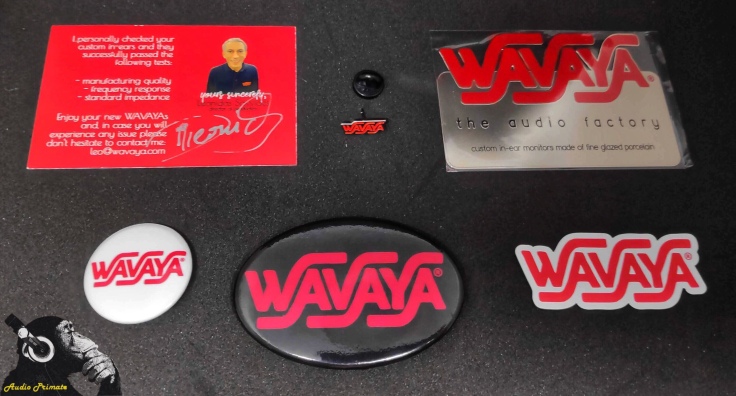
Unboxing
The Wavaya arrived by DHL courier in a heavily padded bag. Breaking into the goodies, it revealed a medium sized cardboard red and white box, adorned with the Wavaya corporate logo and “The Audio Factory” emblazoned on the side. Apart from that, the box is closed with a silver “guarantee seal’ sticker, again in the Wavaya logo. Opening the box, the only other writing you see is a nice “handcrafted especially for you” message under the flap. It’s a simple but fun presentation, and while it won’t be the most elaborate unboxing experience you will ever see, still manages to look classy.
Popping open the box and removing a covering layer of packing foam reveals some printed care instructions for the porcelain IEM shells on a small piece of card (actually pretty useful, as most people won’t have owned a set of porcelain earphones before). Underneath that is a polystyrene layer with various cutouts for the rest of the contents. There are an interesting series of accessories, with various Wavaya branded pins, badges and stickers (four in total), a Wavaya business card made out of metal and another business card emblazoned with the slogan “Quality Comes First”. This card serves a practical purpose, serving as the confirmation of QC, with a picture of Wavaya’s Head of Production on the back, along with confirmation of what was checked and his direct contact details if any issues are experienced. This is hand signed, and gives a nice personal touch.
Another interesting addition is a small plastic case full of metal cleaning tools. Initially I thought they were for the IEM, but after checking with Wavaya, they are actually for cleaning your ears, which is novel. I will admit I haven’t tried them yet, but it is certainly a new accessory set in the CIEM world as far as I’m aware. They look like a cross between a small set of nailfiles and some miniature kitchen whisks, but presume they will come in useful if I ever need to give my earholes a proper deep clean.
In the centre of the box is another cardboard box with the Wavaya logo. This contains the IEM case and IEMs themselves, along with the warranty instructions and a bit of back story about the brand itself. The IEM case is a two-part rectangular Italian leather carrying case, where the IEMs are neatly packed inside. The case is a seamless cured leather construction, with an embossed Wavaya logo on one side and the model name and logo printed in white on the other. The case is personalised with the name of the owner and the month of manufacture, giving another small personal touch to proceedings. Opening the case reveals the IEMs and cable, separated by a leather cable winder which helps keep the two earpieces secure when packed away, and houses another standard IEM wax-picking tool.
All in all, for a custom IEM, this is a pretty comprehensive load out, with the case feeling particularly high quality. It also serves a more practical purpose, with the hygroscopic properties of leather serving to naturally absorb moisture from the CIEMs when stored after use. For the price of the Quadra, the package feels well thought out and carries that all important attention to detail that is key for a feel-good customer experience.
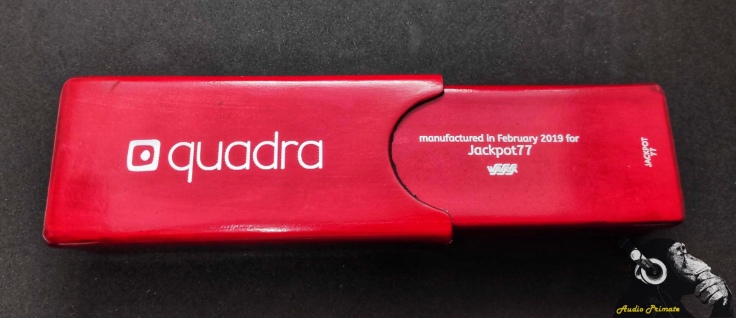
Build and design
Wavaya currently only manufacture custom in-ears, so all models are custom moulded for the ears of the individual users. They are fairly unusual in that they are the only manufacturer currently using porcelain for the IEM shells. They claim this has various benefits in terms of comfort and fit, with the porcelain quickly adapting to the temperature of the ear and being naturally hypo-allergenic.
In terms of build, the CIEM moulds are 3D printed and then filled with a special porcelain / photopolymer mix. The shells then go through multiple curing, firing and glazing processes to get to the final product – Wavaya actually print two of each shell piece during initial manufacture, keeping the best pieces to assemble the final earphone. The shells are made in two pieces, with a clear seam between them. There is also no faceplate to speak of, the buyer being given a choice between a metal Wavaya logo or various Swarovski Crystal designs (if you go to their signature range). I have read that Wavaya will also produce IEMs without any logo or decoration on request, but haven’t confirmed that with the manufacturer.
The fit between the two pieces is good, the two shell segments sitting flush against each other without any obvious gaps or imperfections. There is an obvious “join line”, but this is as you would expect from a piece of porcelain, and gives the IEM a strangely organic look. The finish is very smooth throughout, the whole IEM feeling silky to the touch and absent any sharp edges or rough surfaces. There is a shine that comes off the shells due to the glazing that catches the light, giving the IEMs a polished appearance. I opted for a light blue shell with additional mica being added to the porcelain mix to provide a really subtle glittery speckling throughout the casing. Being a porcelain construction, there are no air bubbles or other imperfections visible on the shells. I’m not sure whether this is due to the different method of construction or the execution by the team over in Cyprus, but either way, it looks good. Overall, the appearance of the Wavaya is textured and unique, giving the impression of an object more like a small piece of jewellery or ornament than an audio item.
The logo is made out of solid metal and is fixed to a raised “plinth” on the shell to give a 3D effect. This gives quite a bold impression on the outer shell, which people will either love or hate – personally I like the silver logo, and think it adds another unusual element to an already unusual design, but I imagine this won’t appeal to everyone. The design process makes fitting more traditional faceplates somewhat difficult, but fans of serious bling will be able to satisfy their leanings with some Swarovski crystal designs that can be fitted instead, so between the two options most clients should be happy.
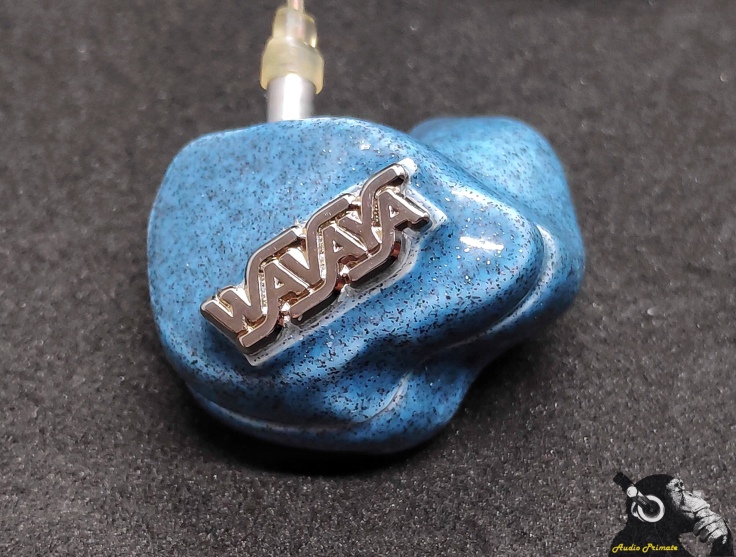
Fit
The fit of the IEM is impeccable. I went for a closed jaw impression, and both the comfort and the seal is spot on, comfortably the best I have had out of the four CIEMs I have owned so far. They lock tightly into the ear, and maintain a working seal when walking around and a decent (if not total) seal when I am eating, so are ideal for me for long term daily use. The manufacturer makes some bold claims on their website about the comfort of the porcelain shells, and whether or not the science behind some of it makes sense, in the main I am happy to confirm they are right. The porcelain quickly gets up to the same temperature as the skin in your ear, and can sit in the ears for hours with no sense of itching or irritability. It seems to disappear in the ear once fully warmed up, whereas my more traditional acrylic CIEMs are always “present” in my ears, leaving me aware I have something blocking my ear canals.
The longest listening session I have managed so far with the Quadra is four hours without a break, but I could easily have listened for longer, so I am happy to confirm that wearing comfort isn’t an issue. I also notice that my ears seem to produce less wax during and after use of the Wavaya compared to my other CIEMs – I did recently have my ears micro-suctioned, so please don’t take this as gospel, but they definitely do seem to be an easy to wear IEM.
It is also worth noting that Wavaya scan the moulds that are sent across in the standard STL format as part of the manufacturing process, and were happy to provide me with a copy to use for other CIEMs in future. They should also be able to accept impressions in STL format, making things a bit easier if you already have a set of impressions on file somewhere.
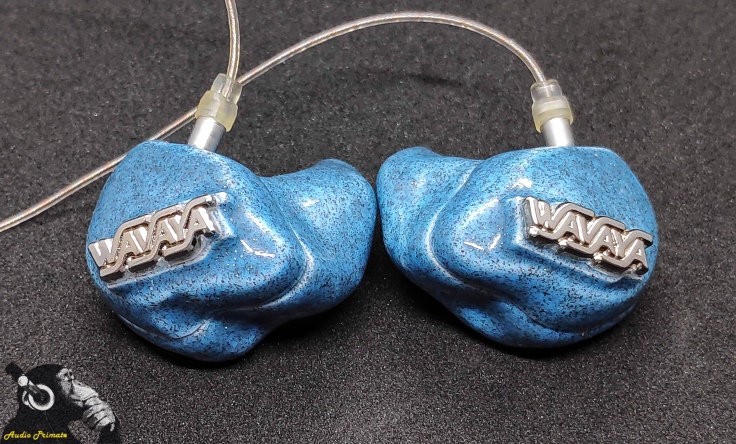
Initial impressions on sound
The Quadra are marketed on the Wavaya website as “a powerful CIEM, suitable for bassists and drummers, and in general rock and pop musicians”. They also state that they are less suited for classical or soft music. Reading that, I was expecting something thick and bassy, with a classic V shaped tuning. While they certainly aren’t bass shy (especially for an all-BA model), I actually think the sound is a lot more balanced than the initial description implies.
There is a definite presence in the lower end, with a solid midbass quantity and decent extension into the lower sub bass registers. It also has a decent sense of punch for an all-armature setup, not quite moving a much air as a dynamic driver due to the physics involved, but still generating a tidy snap to snare drum hits and other percussion sounds. The emphasis lessens slightly the further down the Hz you go, but this feels like more of a gradual slope rather than a more typical mid bass “thumb”.
Moving up to the midrange, this is presented in quite an intimate and forward manner, with the vocals pushing forward towards the listener and the rest of the instruments spreading out laterally across the stage. There are still occasional hints that the bass and treble are slightly more prominent on some tracks, but to me this feels like more of an XXx shaped tuning with the vocal push. It evokes memories of one of my first audiophile pieces of gear, the Aurisonics ASG-1Plus – that was another stage tuned monitor, and one of my all time favourites.
Vocals are refined and velvety, with a slightly larger than average size due to the perceived proximity to the listener. There is good clarity in the delivery, with the Quadra catching subtle details in vocal phrasing and providing a nicely defined bite to some tracks without coming across as harsh or peaky.
Guitar and other electric instruments carry a moderate sense of weight, warmed and beefed up slightly by the bass underneath. Cutting rock riffs fizz with energy, and keep enough of an edge to avoid getting blurry or smudged, retaining the overall impression of clarity in the most frenetic of tracks. Tonality leans more towards musical than reference, but there is a fairly accurate timbre to instruments like piano and acoustic guitar, the Quadra revealing its roots as a stage monitor with a healthy sense of “realism” in the presentation.
Treble is delicate and surprisingly refined, notes shimmering in a black background at the top end of the stage. In fact, the notes almost feel like they don’t HAVE a backdrop, hanging in a space in the middle of your head and pushing out along the x axis. This is definitely a stage tuning, as despite the excellent extension, there is no hint of fatigue or spikiness in the presentation.
This sticks close to my preferred style of treble tuning, with a sweetness and thickness to the body of the notes, bolstered by a fine layer of crystalline detail on the fringe. Detail in the upper registers is very good for the price, adding small micro details into the blank space around each instrument and granting the Quadra a very expressive character when it comes to capturing the raw emotion in a piece of music.
Overall, while this isn’t a flat or neutral tuning in the traditional sense of the word, I’d definitely say this is a balanced sounding IEM, painting a musical and tonally rich sound for the listener, with plenty of detail to spare.
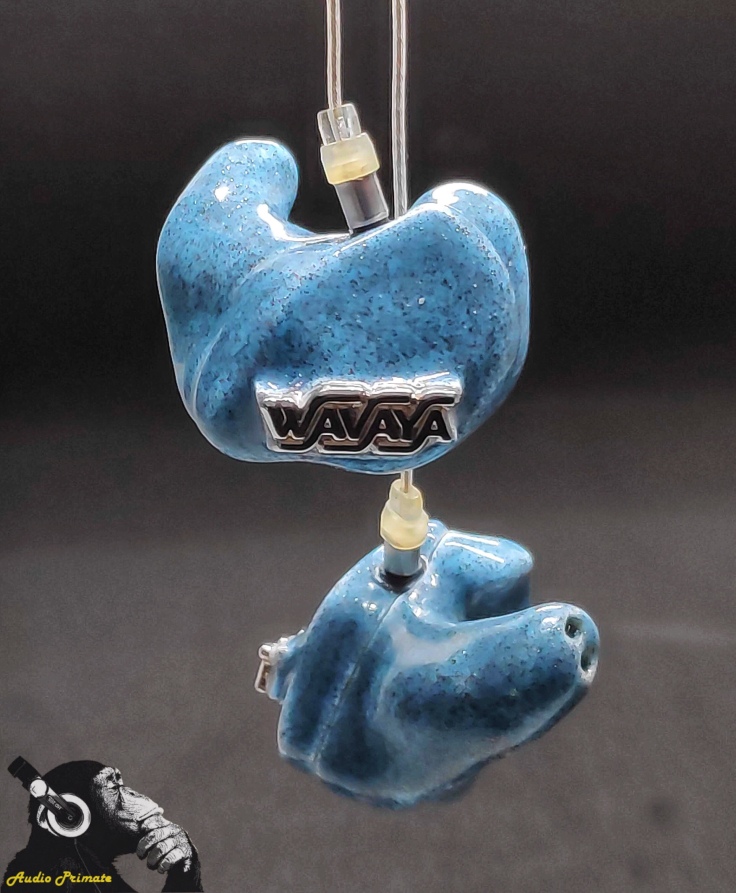
Bass
Delving into the bass in more detail, “Heaven” from Emile Sande is the first track up on the playlist. This track kicks off with a solid sub bass thrum, which is handled without issue by the dual woofer setup in the Quadra. It isn’t the most definitive sub bass in terms of sheer volume, but there is certainly more than enough quantity to make the most of sub-heavy tracks without sounding light or anaemic. Playing “Why So Serious?” from The Dark Knight soundtrack underlines this capability, handling the subsonic pulses that occur around the 3 minute mark with ease, kicking off some serious subterranean rumble in the inner ear.
Extension is excellent, the bass dropping low before it starts tapering off. Songs like “Get Lucky” by Daft Punk feel suitably bottomless, the bass keeping on digging further into the basement with each line.
Kicking on to another one of my favourite bass testers, “Bad Rain” by Slash is full of gritty detail, the growl of the bass guitar riff that underpins the track sounding menacing and full of texture as the strings reverberate. Again, notes don’t sound overly thick or heavyweight, but do pack a muscular solidity on the outer edges, giving an impression of finely grained sandpaper as each note decays in the ear.
With regards to bass texture, I’d classify the Quadra as on the drier side. Bass guitar still sounds lithe and nimble, but not completely liquid, the clarity and detailing around the outside of the notes stopping the bass from sounding fully smooth in the ear. “Hello, It’s Me” by Sister Hazel is a good example, with the chocolatey thickness of the opening bassline coming through with plenty of detail, slinking around the lower end of the soundscape but stopping short of fully coating everything in its unctuous goodness. The bass has slightly too much speed and texture to be considered liquid, the notes decaying a little too quickly to fully melt into the background after the initial impact.
Both the Slash and Sister Hazel tracks illustrate another aspect of the Quadra performance, highlighting the impressive snap in the drums. As an all-BA setup, the laws of physics dictate that this IEM is never going to move as much air into the ear as a dynamic driver equipped model, but the Quadra never feels lacking in terms of physical impact, which is quite impressive. Snare drums hit quickly in the eardrum, and land with genuine punch, and bass drums have a firm thud that is heard, but not quite felt. Again, the speed and agility of the drivers helps here, with the Quadra exhibiting bags of control in the lower ranges. Feeding “Coming Home” by the prog rock supergroup Sons Of Apollo through the Quadra, the multiple drum fills from Mike Portnoy roll across the back of the soundstage like well-defined thunder, each kick drum or tom tom hit landing cleanly in the ear and leaving the listener able to follow the machine gun rhythm of the track without smearing the notes together.
Picking another Portnoy-backed track (“Elevate” by The Winery Dogs), the Quadra makes short work of the complex drum fills, matching them with Billy Sheehan’s complementary quickfire bass without muddying either instrument. Further into the track, Sheehan and Kotzen engage in some bass / guitar duelling, each instrument mirroring the other in a flurry of notes. One less resolving IEMs this can tend to blend together into a mushy amalgamation of the two guitar lines, but again the Quadra keeps both distinct and easily traceable in the ear. It doesn’t paint a huge amount of physical space between either instrument, but I think this is as much to do with the way the track was originally recorded as the IEM itself.
In the main, this is a tastefully done bass for people who aren’t afraid of a little low end, but are a little reticent of joining the full blown bass head crowd. The blend of texture, speed and a north of neutral quantity that gives just the right amount of “thickness” to get your toes tapping gives the Quadra a very good foundation to build on. This isn’t a flat or neutral presentation, but the Quadra is definitely all the better for that. It adds warmth to acoustic genres, a little hum and rumble to electronica and a decent amount of grunt to rockier tracks, giving the Wavaya model a nice all-round appeal.
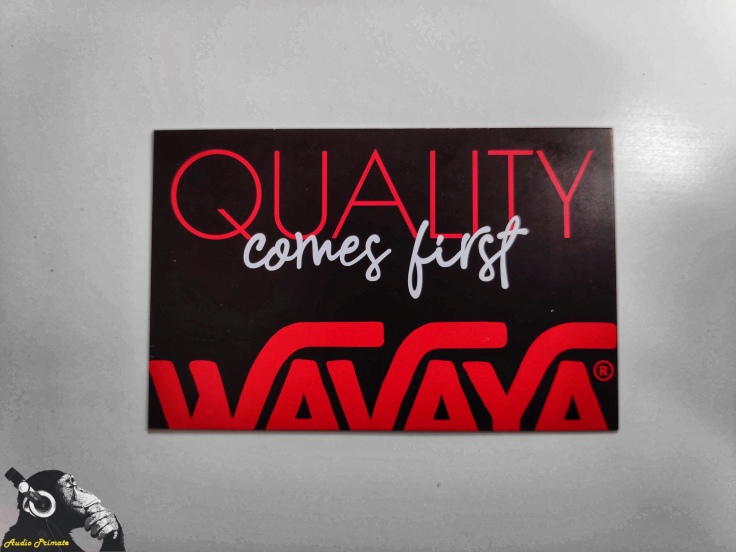
Mids
Sliding up the frequency range, the bass to mid transition is handled extremely well, without any bleed across the frequencies and plenty of space for both to express themselves. The stage position of the midrange is fairly forward, the Quadra putting you close to the front row of the auditorium with the performers rather than further been in the crowd. There is an element of sculpting to my ears around the vocal ranges, making them feel slightly more prominent than the surrounding guitars or other instruments, but it is quite subtly done.
Tonality is slightly sweet, with acoustic guitars sounding particularly good. There is just a hint of warmth to proceedings, giving the Quadra an organic and natural sound. These aren’t stuffy or cloying, however, with the complex crossover network giving plenty of space and clarity in-between the instruments, despite the warmth.
Starting with some acoustic fare, “Live At Carnegie Hall” by Joe Bonamassa sounds superb, the chiming of Joe’s guitar playing off against the string accompaniment to give a rich and vibrant “live” feel to the tracks. “Nobody ‘Cept You” by Jack Savoretti is a simple acoustic guitar driven cover of a Bob Dylan track, placing Savoretti’s guitar and gravelly vocal front and centre. The Quadra bring the singer front and centre in the stage, with the guitar reverberating and echoing out into the surrounding space, giving a clean backing to Savoretti’s honeyed rasp. The instrumentation feels very solid and real in the ear here, giving a solid mental picture to the listener of the actual instrument being played.
Taking a more electric vibe, I go searching for midrange harshness with “Starlight” by Slash. The mid tempo rocker starts with some deliberately dissonant lead guitar work, which the Wavaya IEM manages to portray with just enough bite to sound alive, but not jagged or unpleasant. The subtle vibrato of the guitarist’s fingers on the neck of the guitar as the notes fade out at the 34 second mark is cleanly heard in the ear, along with the subtle recording sounds a few seconds later. All of this is delivered without a hint of unpleasantness, the Quadra making the guitar positively sing. This is definitely an IEM that is tuned to appreciate (and complement) distorted rock guitar.
“World On Fire” by the same artist is a good tester for speed and congestion through the midrange, and the Quadra come out very well here too. The track contains a quick fire riff that can lose definition on a less resolving monitor as the thickness of the guitar blends the notes together. The Quadra still presents the chugging riff with plenty of meat, but keeps enough edge between each note to keep them separate as they roar on throughout the track. To be clear, this isn’t the most clinical or separating IEM I have in my collection in absolute terms (I own a Zeus-XR, so there isn’t much in the IEM world that does compete there), but there is plenty of speed and technical capability baked in to the porcelain shells here.
Switching to my sibilance testers, “Whiskey And You” by Chris Stapleton is a usual favourite to check the sharpness of male vocals. The track is a simple acoustic ballad, with just Stapleton’s powerful voice and an acoustic guitar carrying the entire tune. It sounds rich and full on the Quadra, the singer’s distinctive rasp coming through loud and throaty. There are sections of the track around the 1:50 and 3:07 marks that can be harsh on some IEMs with mid-range tuning peaks, Stapleton making a sound like a mountain being sandpapered as he belts out the chorus. The Quadra isn’t the smoothest ride I’ve ever heard here, but still manages to keep the tune enjoyable rather than unpleasantly grating. It actually stays pretty true to the original mastering (which must have been done in a bucket of gravel), keeping the raw edge of the vocal without over-emphasising the ragged delivery. This IEM actually gives one of my favourite renditions of this track for my personal preferences, the substance and texture to both the guitar and vocal thickening out the ballad into something emotive and personal.
Vocals in general sound strong on the Quadra, the quad-BA setup not playing any favourites between male and female vocals, presenting both with a slight sweetness and a full, rich tone that packs in plenty of emotion. Listening to something like “Waiting On The World To Change” by Keb’Mo and Taj Mahal, you get the ultra-smoothness of Keb’Mo paired with the Cab Calloway roughness of Mr Mahal, both voices carrying equal emphasis and both absolutely dripping with expression. Vocal nuance and formative breath sounds come through clearly in the mix, giving the Quadra a very expressive tone with “breathier” artists. Paired with the slightly forward stage position and intimate presentation, the Quadra has an approach that is almost reminiscent of the older Final Audio models, but not quite as specialist. It is rare for an IEM to be able to capture a lot of the detail in a performance and also get a similar dose of the anima or emotion behind it, but the Quadra does this well. Very well, in fact.
Tonality of other midrange instruments like piano and brass is similarly warm, not feeling overly coloured and carrying a fairly correct timbre and sense of reality. I think this forms part of the emotional engagement that the Quadra are very good at, with instruments sounding like they should, allowing the brain to just concentrate on the music being played rather than the colouration the IEMs are giving their favourite piano or saxophone. Again, these are more musical than analytical, so they aren’t 100% accurate or transparent, but they do a pretty good job of presenting a musical landscape that is recongnisable in tone but still enjoyable at the same time.
The midrange is where a lot of the magic happens in the styles of music I listen to, and the Quadra capture that magic perfectly for me. They have the right combination of technical capability and emotional heft to really involve the listener in the music they are listening to, and for me are the highlight of this IEM.
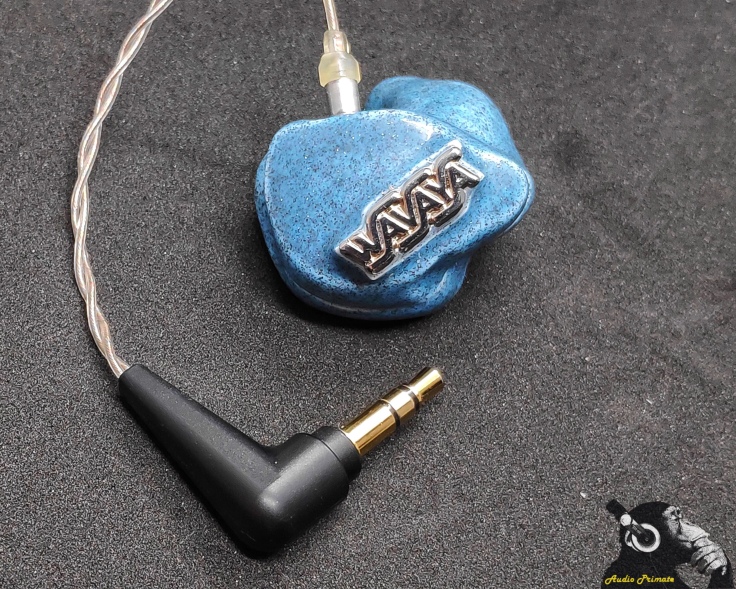
Treble
The Quadra user two tweeters for the high range, paired separately with two bass/midrange woofers using a complex crossover and band passing system to effective create two overlapping “pairs” of drivers covering the full frequency range. The Wavaya website points to the Quadra being balanced up to 10kHz, and despite the gentle downwards slope from the midrange into the treble, there is still ample extension for most genres of music. Highs sound clean and solid, and while they aren’t quite as emphasised as the frequencies underneath, they provide a good layer of delicacy and some headroom to the sound.
Hi-hat and cymbals sound crisp but not overly splashy, decaying relatively quickly once hit. They just shy away from sounding subdued, but definitely aren’t overly tizzy or emphasised. Listening to “Go” by The Chemical Brothers, the driving ‘tssk’ sound of the hi-hats that usually sits on top of the rhythm feels a little muted, although still clearly detailed. Fall Out Boy’s cover of “Beat It” renders better with these IEMs, the cymbal work again fading quickly but sounding sharper and snappier, carrying plenty of crisp detail in each strike.
The Quadra deal quite comfortably with the higher stringed instruments and more synthetic fare as well. The layered high violins and swirly synth noises that make up the track “Chi Mai” by the classical fusion duo Duel sound clean and pure, with the violin coming through with some of the midrange sweetness. The synthesiser sounds more delicate and almost gossamer-like in the ear, keeping the edges of notes clean and crisp and but filling them with air like a musical version of a meringue, so they seem to almost float around the top end of the sound.
Wavaya use tubeless outputs in all their models, and the Quadra bear some of the classic hallmark of that sort of setup, pushing a decent amount of air and space into the upper portion of the soundscape despite the relative lack of overall decibels. There is depth and substance to the treble, but not at the expense of making the sound feel closed in, the Quadra doing a good job of presenting a top end that feels open. Granted, it’s more the sort of open feel you get to the sound when a band are playing in a festival, with the notes radiating outwards and dying off as they fade into the distance rather than bouncing off the walls of the venue and back into your ears, but it still gives a pleasantly airy feel to the upper part of the sound.
As a result, harshness isn’t an issue with these IEMs. I can quite comfortably play “Starlight” by Slash and Myles Kennedy without wincing at the dissonant harmonics in the guitar intro, and it handles other similarly piercing tracks like “My Kind Of Love” by Emile Sande with just enough roundness to the notes to avoid lacerating the eardrum. There is still a punchy sense of edge to hotly mastered recordings, so the Quadra doesn’t attain its easy going nature through overly smoothing its response, but it is able to stay inside the lines of listenability on pretty much anything I have thrown at it so far. The stage pedigree of this model come in useful here, the Quadra packing plenty of detail and crispness but still managing to remain non-fatiguing with the ugliest of source material
“Go” by The Chemical Brothers is one of my last staple treble test tracks (try saying that after a few frosty beverages), kicking off with some crisp hi-hats providing the rhythmic counterpoint to the pumping bassline. Again, the Quadra is restrained here, with a quick and almost deadened decay. The cymbals still feel present and carry weight, pushing the song along nicely. The other thing I look for here is the airy synth notes that start peppering the sonic landscape at around the 1:17 mark. The Quadra deals with these well, sweeping across the back of the stage and cutting cleanly through the bass lines underneath. As stated previously, this isn’t treble that will cut glass, but it definitely holds its own against the chunkier sounds in the lower ranges, leaving the listener with a well extended and solidly detailed upper end.
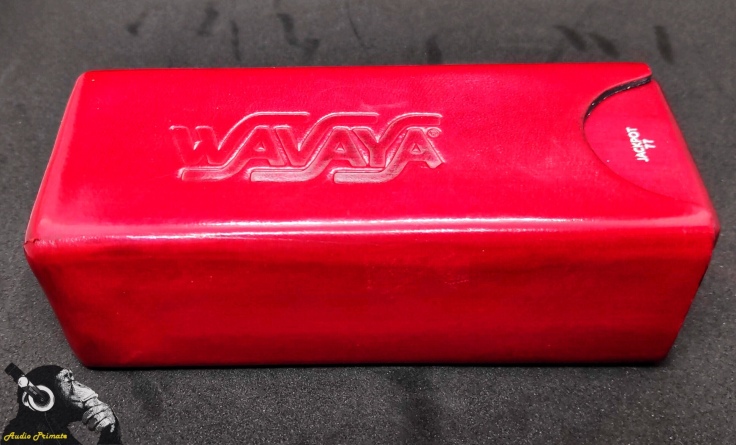
Soundstage, separation and imaging
The Quadra throws out a soundstage that is fairly average in width, sounding more oval than spherical to me, with a modest amount of depth on the z-axis to sounds. You don’t get a huge impression of how close or far away from you the sounds are, more of an idea how far to the left or right they are. Height is quite good. There is a decent but not mind blowing stage spread from left to right, the Wavaya IEM pushing sounds just a little outside the imaginary confines of the listener’s skull in both directions. This is offset with some excellent separation, aided by the previously referenced clarity levels and the relative blackness or lack of perceived background behind each note. Multiple lines of instrumentation resolve without congestion or smearing, and in some cases even the individual notes in a particularly well recorded guitar chord can be discerned as part of the overall whole.
A simple tester I like to use for this is “Everybody Knows She’s Mine” by Blackberry Smoke. There is an acoustic guitar lick that kicks in 15 or so seconds into the track that sits on top of a much fatter electric riff that drives the song along. The Quadra lay this down clearly in the ear, allowing it just enough room to breathe and resolve in the mind without sinking into the swampy country rock riff underneath. To temper this with a bit of realism, please bear in mind that these are NOT the most detailed or analytical IEMs you will ever hear (and for the price, it would be very surprising if they laid claim to that title), but these IEMs can definitely perform at a high level of technicality in this particular facet.
Layering is similarly good, the Quadra proving adept at keeping multiple strands of musical information neatly organised and sliced into the relevant sections. Again, clarity allows the listener to concentrate on a particular instrument in the mix and pick it out clearly, without blurring or blending into the notes around it.
The only thing stopping this from being a tour de force in this particular section of the review is the imaging. The Quadra has a distinct left / right spread, and while the individual instrument images are presented in the head (or mine, anyway!) as being larger than average, they are not always easy to pin down to a specific location. This is due in part to the more forward and intimate nature of the tuning, with things pushing forward around the listener as opposed to pulling a bit further back and laying themselves out in a more typical stage set up. This certainly isn’t an issue for day to day use or music enjoyment, but for those listeners looking for a more 3D or holographic presentation with a more coherent “image” of the whole stage, I suspect the electrostatic tweeter models a little further up the Wavaya food chain would probably be more capable in that regard.

Synergy and power requirements
The Quadra has a nominal impedance of 60 Ohms, meaning it should be able to take a fair bit of power. It also means it matches well with pretty much everything I’ve paired it with, the higher than typical impedance meaning that hiss is pretty much non existent and the response stays relatively even between all of my current sources. It matches this impedance with a sensitivity of 115dB/mW, meaning they get PLENTY loud enough from sources like my mobile phone without any effort at all.
The IEM feels quite transparent in day to day use, the high clarity levels nd lack of hiss allowing it to take advantage of any additional resolution or technical capability in my higher end DAPs to eke a little more out of the musical background. Conversely, the musical signature plays nicely with low end sources too, remaining even and silky even when played through something like my Pocofone F1, which isn’t burdened with the best of audio outputs (to put it mildly). The Quadra do tighten up a bit when fed properly, so hooking them up to a portable amp like the ALO Continental V5 does help maximise the dynamics in the music, but certainly isn’t essential for day to day use.
Bottom line – if you have a higher end music source or amplifier, the Quadra will make best use of it, but this isn’t an IEM that scales ridiculously with the higher end gear I’ve tried it with so far, so amping or a DAP that cost more than your first proper car isn’t a necessity to enjoy the full potential of these IEMs.
In terms of tonality, I actually prefer a warmer source with these, to bring a little more musicality out of the bass – again, that’s just my particular preference though. This isn’t an IEM that is particularly picky about being matched with a cool or warming player, remaining natural or neutral enough to pair well with both.
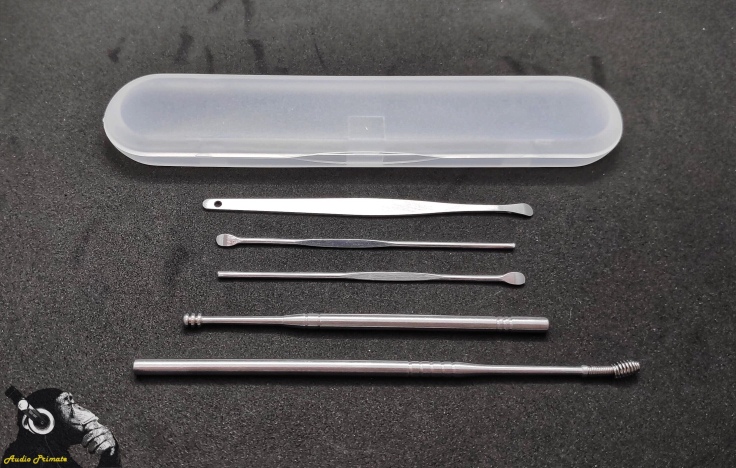
Isolation
It should go without saying, but the Quadra isolates well. It isn’t the most isolating CIEM I own, so it isn’t a complete black hole for noise, but it easily blocks out enough background hum to be used on public transport or a long haul flight (and also on a stage which is the primary intended use case). According to Wavaya, the internal filling used is actually quite dense, so while it isn’t quite as much of an earplug as some customs I own, it still blocks more noise than most of my non-custom IEMs. This is easily enough isolation to wipe yourself out on a busy road if you aren’t paying attention, so as always, use with care in environments where being deaf to your surroundings isn’t a good thing.

Comparisons
(Note – for simplicity, all comparisons below were done using the Cayin N5IIs in high gain, volume matched with a MiniDSP E.A.R.S rig)
Dunu DK-4001 ($899) – Hybrid 1xDD 4xBA universal
The DK-4001 is the latest flagship from the Chinese audio brand Dunu, sitting around the the same sort of price bracket as the Quadra after customisation. Unlike the Quadra, it is a universal IEM, and a hybrid (meaning it uses both a dynamic driver and some balanced armatures to produce the overall sound). It is always difficult to compare universal and custom IEMs, but they actually have a surprisingly similar take on sound, so I thought this would be a useful comparison.
Starting with the packaging, the Dunu definitely goes for a more ostentatious style than the Wavaya model, with a box that is about twice the size and covered in classic audiophile style with various pictures and tech specs. It feels almost Apple-esque in its presentation, giving the Dunu a nicely premium feel compared to the more reserved Wavaya package. Accessories are actually fairly similar – disregarding the tips, the Dunu comes with a nice leather carry case, which looks good, but doesn’t quite give the same feel as the unique Wavaya leather box. Other load outs are similar, until you come to the cable. The cable that comes with the DK-4001 is one of a kind, made of high-purity 7N OCC copper and sporting an interchangeable connector which can be fitted with four different connectors, ranging from 2.5mm TRRS all the way up to 4.4mm Pentaconn. My Quadra came with a Linux G2 Bax, which is a superb cable, but the Dunu with its high quality construction and ability to use with pretty much all the DAPs on the market edges it a little here.
Construction wise there isn’t much point comparing the two – the fit is better on the Wavaya (unsurprisingly), with the Dunu sporting a very ergonomic but still universal shell design. Both come out well here.
Moving on to the sound, the Wavaya are slightly easier to drive, needing a few notches less on my N5IIS to get the same sort of volume level as the Dunu. In terms of tone, The Quadra are slightly warmer than the 4001, carrying a little more mid bass presence in the main sound signature. They feel a little more balanced and full than the Dunu, with less of a sub bass kick (only marginally) but more mid bass than the relatively restrained Dunu. Detail and texture is also close – the 4001 is powered in the low end by a giant 13mm dual-sided beryllium DD, and it kicks out plenty of detail in the low end, along with a decent if not earth shattering punch. The Quadra can’t quite match the physical impact (although it isn’t far off), but does a good job keeping pace with the texture and detail here – it is difficult to pull the two apart.
In terms of mids, the Dunu feels a little sharp and vinegary in comparison to the more rich Quadra, giving an edge to the upper mids that can make some male vocals sound a little hard in direct comparison. Listening to someone like Matt Andersen, the Dunu captures the edges of the notes in his vocal delivery, where the Quadra tends to present them with a thicker and more substantial body, and a more organic and forgiving tone. Detail level is comparable on both — the Dunu can be a bit of a detail monster with its upper-mid spike and BA highs, but the Quadra comfortably keeps pace in terms of resolution on my usual test tracks, never leaving me feeling like I was missing any subtle nuances.
Guitars a little spicier and crunchier on the Dunu, but lose a but of weight and physical heft as a trade off. Piano and other mid range instruments sound cleaner but colder on the Dunu, with the Quadra edging it in terms of a more realistic timbre and tonality for my preference here. Tone is probably the biggest differentiator here – the Quadra have the old Final Audio trick of capturing the emotion in the midrange down pretty well, whereas the Dunu IEM is going for much more of a clean and analytical sound. It is down to preference as to which is better – I think the Quadra feels a little less sculpted and more natural, but my preference typically leans away from sharper or more analytical monitors as a rule of thumb.
Treble is again similar on both, with the Dunu carrying less weight up top but a crispier and more sparkling edge. Detail is again very similar, with the Dunu possibly shading it overall, but only by the thinnest of margins. Again, this is more a battle of styles, with both earphones producing treble that is very capable and extended, but in different styles. The Dunu crispness will appeal to treble heads a bit more I imagine, whereas the more organic and thicker feel to the Quadra’s top end will lean more toward fans of a warmer sound.
Separation and layering is close, with the Dunu presenting a slightly less full bodied and sharper sound, which gives notes.a little more room to breathe, but at the expense of some heft. It will depend on preference which sounds best to the listener here, but the Quadra definitely keeps pace with the Dunu flagship. Imaging is average on both IEMs, so again, not much to split them here.
Overall, these two IEMs are different enough to offer different flavours to the listener, but similar enough in terms of technical capability to offer the same sort of quality of sound. If you are more of a treble head who prefers a cooler sound or you are someone for whom the interchangeable cable terminations is a real selling point then the Dunu would be my recommendation, but if you prefer a weightier or more emotional and musical sound which still has plenty of detail, the Quadra are an easy recommend. Both IEMs punch above their price, and I’m personally glad I don’t have to choose myself.
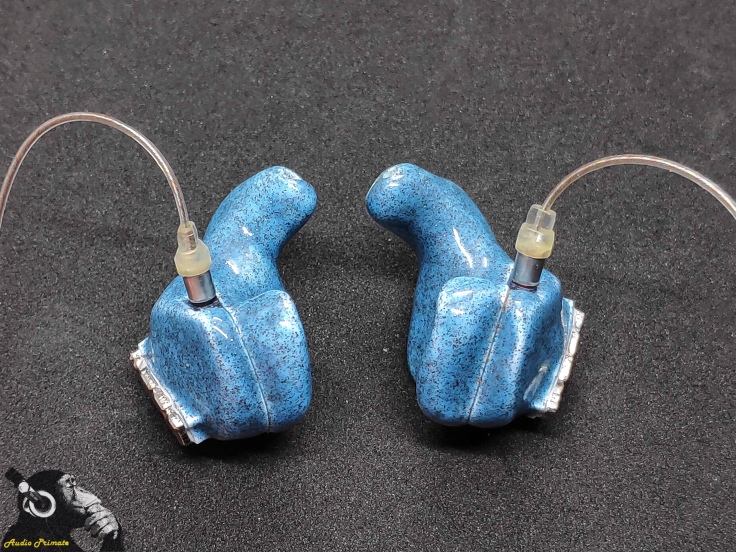
Stealthsonics C9 ($1499) – Hybrid 1xDD 8xBA custom IEM
The flagship IEM of the current Stealthsonics range is probably a little bit of an unfair comparison, coming in at just over double the cost and packing nine drivers compared to the four in the Quadra. I am including it here for two reasons: to show how well the Quadra competes in the next price bracket up, and also because these are the only two customs I currently have that are made from exactly the same set of ear impressions, as the same digital STL files were used as the basis for both monitors.
Starting with packaging and accessories, the C9 come in a carbon fibre effect box about the same size as the Wavaya packaging, with an embossed logo on the front. It is undeniably cool, so sets the tone nicely. The actual load out is fairly similar, with a case, some travel adapters and a small cleaning tool taking up most of the Stealthsonics box. The only other notable accessory is a second IEM cable with a mic. The case is nice (and etched with the owner’s name), but isn’t quite the same quality as the all-leather Wavaya case. There is a lot more room inside the Stealthsonics case to add additional cables or a small DAP, but it lacks the solidity and simple winding mechanism of the Wavaya case, which I feel keeps the IEMs more securely locked in place. The stock cable on the C9 is also a slightly higher quality than a standard Plastics One braided cable, so if you don’t choose to upgrade to the Linum cables then that may be a consideration. Overall, honours fairly even (apart from the case).
In terms of fit, the IEM shells aren’t identical (even though they are both taken from the same STL file). The designers at Wavaya have opted for a slightly longer nozzle, and the Stealthsonics team have a slightly shortened nozzle but a marginally thicker stem. In use, both provide an excellent fit, with the thicker nozzle of the Stealthsonics allowing full seal to be maintained while chewing, where the Wavaya occasionally breaks seal. Both are comfortable to wear for extended periods, but the porcelain shells of the Quadra feel less “obvious” in the ear after a while, seeming to melt away in use in comparison to the very comfy but always “present” feel of wearing the Stealthsonics shells. My ears also seems to produce less wax on the IEM shells using the Quadra.
Sound wise, both present a musical take on balanced – the C9 is designed as a top-tier reference monitor, sporting one 10mm dynamic driver and 8 balanced armatures in a hybrid configuration. It shoots for more of a flat frequency response, but doesn’t lack for musicality due to the punchy 10mm dynamic driver picking up the bass.
In tone, the models are actually fairly similar, with the C9 giving a slightly warmer tone to the music due to the DD underpinning everything. There is more low end on display with the C9, which has a thicker and more present midbass than the relatively cleaner Quadra. Sub bass is also more powerful with the dynamic driver, giving a little more thrum to my usual test tracks from artists like Emile Sande. There is a difference in texture as well – both IEMs produce a beautifully detailed bass, but the C9 is a fraction slower in its decay, letting the bass drum impacts linger a little longer in the ear compared to the snappiness of the all-BA Quadra. The C9 obviously shifts a little more air into the ear with the 10mm driver, so for sheer physicality, the C9 has an advantage here, presenting drums with more physical impact and slam.
Moving up to the midrange, vocals are pushed further forward on the Quadra, which presents a more compact and intimate staging to the listener. Singers are a little less thick, with the trailing edge of notes feeling a little sharper on the ear from the Wavaya model. It balances this out with some cooler air between the instruments, allowing for a little more breathing room and sense of crispness on stringed instrumentation in particular compared to the Stealthsonics flagship. Detail level is similar, with the crisper notes of the Quadra giving a more immediate impression of clarity. The C9 does pack in a LOT of detailing into the main mix, but it resolves in a less immediate way, matching (and occasionally exceeding) the Quadra in raw resolution, but filling the notes out a little more so it doesn’t always scream for attention. The emotional sense of rawness that the Quadra can bring to some vocal deliveries is replaced by a sweeter and more lush tone with the C9.
Treble is nicely extended on both monitors, but the C9 has the nominal edge with a rated extension of 40kHz. This is done so the treble will stay relatively flat past the usual hearing threshold, and it does provide to have a slightly stronger pedigree in the really high reaches of some of my tracks. Both monitors share a similar presentation, going for a thicker and more bodied presentation rather than cut-glass etching, so there is nothing to separate them from a preference point for me there.
The additional extension on the C9 aids its imaging, which is top-tier, and presents a stage that is a little further back from the listener but much easier to locate each individual instrument on in terms of position relative to the listener, giving a more solid stage image than the Quadra. The Wavaya model counters with a slightly cleaner sense of separation, using the slightly larger space between each instrument to keep things more obviously separated and layered. Again, the C9 is a top tier operator here, but the relative warmth of the tuning makes it a little less apparent in direct comparison to the cleaner Quadra presentation.
In terms of driving power, both IEMs require roughly similar amounts of power to drive from the Cayin DAP I am using, so in practical terms don’t have much to split them. They are also both dead silent – Stealthsonics are another IEM firm that have their roots firmly in the stage musician market, and the non-fatiguing and hissless presentations of both is refreshing.
Overall, the C9 is the fuller and more romantic sounding IEM of the two (which surprised me a little), giving a thicker sound and more physical impact. In terms of technicality the Quadra is able to hang with an IEM twice its price, only falling behind in terms of imaging but matching the C9 in terms of resolution. The Quadra is slightly sharper in tone and presentation, giving a more energetic and musical “vibe” to things, in comparison to the slightly more laid back and smooth presentation the C9 puts out. The C9 is a proper flagship-level IEM, and on a purely technical basis it pulls slightly ahead of the Quadra. If you are looking for something to use in the studio or for critical listening without sacrificing bass or a sense of musicality, the C9 will probably be the better choice out of the two. If you are looking for a monitor for stage use or just for extracting maximum emotion and enjoyment from the music you are listening to without sacrificing on technical capability, the more “in your face” style and tuning of the Quadra make this a very compelling offering for the price.

Campfire Audio Polaris II ($499) – Hybrid 1xDD 1xBA universal
This is another slightly unusual comparison, but the Polaris is one of the cheaper models from the current Campfire Audio range, coming in a couple of hundred dollars below the current list price of the Quadra and sporting a similarly musical tuning. The accessory loadout is also reminiscent of the Quadra, so I thought this would be an interesting matchup.
Starting with packaging, the 2019 edition of the Polaris comes with the beautiful presentation that Campfire Audio is known for, presenting in a small square box wrapped in starry craft paper. The unboxing is undeniably premium, giving the impression of a high end or boutique item. Once you are in to the main product, the accessories are similar in thoroughness to the Wavaya pack – apart form the variety of tips (required for a universal monitor), both IEMs sport a high quality handmade leather case, and both IEMs also provide a few nice extras like badges and lapel pins to go along with a top notch cable.
As far as the case goes, the Wavaya case edges it for me due to its more unique look and extra rigidity, but the new CA cases are undeniably attractive and of a similar quality. The Quadra case scores points due to the unique way you store the IEMs to avoid them knocking together in transit – this is countered by the Campfire team with their inclusion of some small dual compartment fabric bags that the IEM shells are placed into when stored, avoiding any unnecessary scrapes or dings when moving them around. Two very different approaches, but both very appealing and unique to the firm in question.
Build quality is high on both, but not much point comparing directly as the Quadra is a CIEM.
In terms of driveability, the Quadra requires more power to reach the same volume levels as the Polaris, so is slightly less easy to drive on weaker sources. Both IEMs trade on a musical style of tuning, but the Polaris is definitely the bassier of the two by quite a significant margin, being a another hybrid design with the bass being taken care of by a large 10mm dynamic driver. The Polaris tends towards more of a shallow V or W shaped tuning, emphasising bass and treble but without a particularly recessed midrange. In terms of detailing, the Polaris actually holds up pretty well for a bass-heavy IEM in this price bracket, giving decent if not mind blowing clarity. The Quadra feels a little further ahead in terms of overall resolution and transparency, with more fine detail nestling in the space between instruments than the fuller and smoother feeling Polaris 2.
Starting with the bass, the Polaris has a huge subwoofer style tuning that really comes to the fore with bass heavy electronic genres or heavy rock tunes. The control and detail is good for a dynamic driver thanks to Campfire Audio’s “polarity chamber” tuning tech, which stops the bass from getting overly boomy or overbearing despite the quantity. In terms of texture and speed, the Quadra just shades it, providing a cleaner and quicker snap. The Polaris provides a much heavier physical slam factor, and a heavier sub bass emphasis. If you like your bass thick and meaty, the Polaris has the advantage here – if you are a fan of a leaner or tauter low end tuning, you will probably lean towards to the more tradition “BA bass” of the Quadra.
Moving up to the mids, the Quadra again pulls slightly ahead in terms of detail and clarity, presenting a slightly cleaner and cooler sound than the more lush Polaris. The heavier bass underneath provides a much warmer tone to the mid range on the Polaris, giving it a meatier and slightly smoother overall feel. It still manages to cut through the layers of midbass underneath quite successfully, giving a decent rendition of the smaller microdetails on the track, but just losing out in the final pieces of resolution in comparison. Guitars sound thick and chugging on the Polaris, not carrying quite as much bite as the Quadra but trading it for a more emphatic physical presence when the chords land.
The Polaris certainly aren’t a veiled IEM, but the Quadra just feel a shade cooler and cleaner throughout the midrange. This is captured most easily in the vocal presentation, with the Polaris choosing to emphasise the tichness and timbre of a singers voice, with the Quadra bringing a little more edge and rawness to the surface, resulting in a more emotional feel to the presentation. Again it is a battle of preferences here – I feel the Quadra has the slight technical advantage in this frequency range, but if you prefer a warmer and more velvety presentation you may disagree.
Treble on both IEMs is strong in terms of extension, but the Polaris has a little more sparkle and brilliance cutting through the heavy bass in comparison to the more delicate and grounded Quadra. The Polaris leverages some of the Campfire TAEC tuning tech here to get decent expansion in the treble region, and feels a little crisper in the really high regions. Again, neither monitor will win any “screaming hot treble” awards, but both have a technically proficient and nicely matched tuning.
Separation is slightly more noticeable on the Quadra, although the Polaris is again surprisingly proficient in this area, only suffering in direct comparison due to the additional thickness of the notes. Both IEMs are clearly able to resolve the slight background noises in the opening bars of the Escala track “Palladio” without any issue, and tracking multiple guitar lines or complex drum and bass passages on either monitor is fairly straightforward. Layering is again similar, with the Polaris providing a slightly better feel for the imaging of a particular track, fixing the instruments slightly more clearly into a coherent 3D space in my mind compared to the Wavaya model.
Overall, both monitors will appeal to different audiences, but have enough similarities to make this comparison worthwhile. If you are a fan of thunderous bass paired with a midrange and treble that isn’t hugely V-shaped but has enough edge to cut through the sound, the Polaris is a good choice in the sub-$500 bracket. If you can live with less bass and a slightly hazier sense of imaging, the Quadra pushes ahead further technically, producing a sound that is equally as engaging but just a splash more crisp and resolving overall, with a greater sense of emotion.

Overall thoughts
One of the best things about getting to hear and review new audio gear is the feeling when something that wasn’t on your radar comes up and gives you a proper smack around the ears. The Quadra have definitely done that for me. These IEMs have a sense of musicality that really draws the listener into the music, and back it up with plenty of technical ability and some pretty unusual technology and design. The porcelain shells feel great in the ear, and while I haven’t had them long enough to rubber-stamp the durability, they certainly don’t feel fragile or overly delicate. The tubeless design in the shell gives the treble an open feel, and the build and fit is equally impressive. Throw in a unique and actually pretty practical IEM case, a double crossover setup and a boat load of accessories, and the Quadra definitely punches above its price bracket for sheer value for money in the current CIEM market.
As far as sonic quality goes, I think Wavaya have really nailed it here, with a tuning that is musical but still keeps a tight grip on the detail and technicality. This is a sound that really works for my preferences, leaving me listening to whole albums from start to end and forgetting what I was supposed to be doing (usually writing this review!). Sometimes in this hobby you end up listening to the gear more than you listen to the music, so I’m always happy when I get to listen to something that reminds me exactly how good music can sound when you just relax and drift into it.
As always, to balance the above out with a dose of reality, there are some things the Quadra don’t do perfectly. The imaging is a little fuzzy compared to the other technical aspects, and there’s stage could be a little deeper on some tracks. These feel very much like nitpicking though, as the overall impression the Quadra leave me with is one of sheer musical enjoyment, and one I don’t have to sacrifice the detail or resolution in some of my favourite tracks to enjoy. Factor in the price (around 690 Euros at time of writing) for a custom moulded porcelain IEM packing a real leather case and four balanced armatures and I’m happy to say the Quadra lays down an impressive marker for what can be achieved in the sub-$1000 price bracket, and definitely an IEM I would be happy to recommend to almost anyone.

